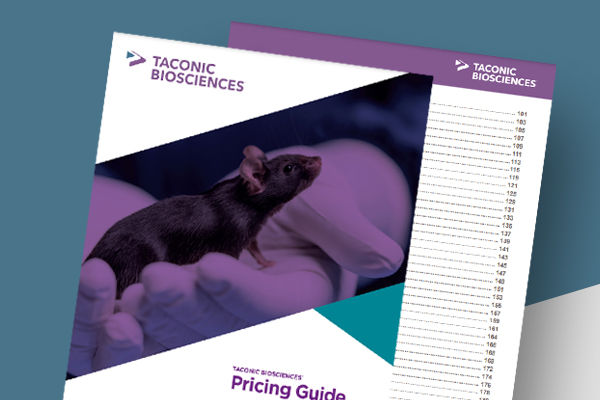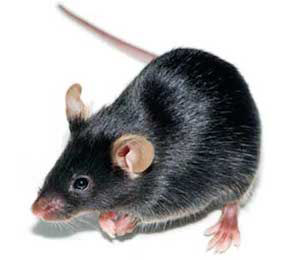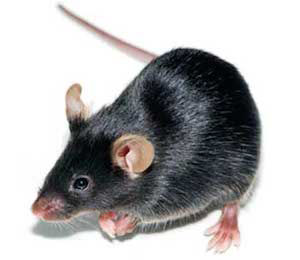| Model No. | Nomenclature | Genotype |
|---|---|---|
| 1549-F | B6.129P2-Apoetm3(APOE*4)Mae N8 | hu/hu |
| 1549-M | B6.129P2-Apoetm3(APOE*4)Mae N8 | hu/hu |
APOE4

- Description
- Related Products & Services
- Data
- Price & Licensing
- Health Report
- Overview
- Genetics
- Guides & Publications
- Applications & Therapeutic Areas
- Transit, Housing & Welfare
- Diet
Overview
Nomenclature: B6.129P2-Apoetm3(APOE*4)Mae N8
- Homozygous for a human APOE4 gene targeted replacement of the endogenous mouse Apoe gene
- Expresses human apolipoprotein E4 isoform under the control of the murine Apoe regulatory sequences
- ApoE is a plasma protein involved in cholesterol transport, with three human isoforms (E2, E3, and E4) that have been associated with atherosclerosis and Alzheimer's Disease (AD)
- E4 occurs in approximately 14% of the human population
- In humans, the E4 allele is associated with increased plasma cholesterol and a greater risk of coronary artery disease
- On a normal diet, this model has normal plasma cholesterol and triglyceride levels, but altered relative quantities of different plasma lipoprotein particles, and delayed clearance of vLDL particles, with only half the clearance rate observed in the APOE3 targeted replacement mice
- On a high-fat diet, develops abnormal serum lipid profiles and atherosclerotic plaques that are more severe than the APOE3 model, with twice the cholesterol, ApoE, and ApoB-48 levels and larger plaques than the APOE3 model
- Exhibits an increased risk of atherosclerosis compared with wild type and APOE3 targeted replacement mice
- Useful for studying the role of human APOE polymorphism in atherosclerosis, lipid metabolism and Alzheimer's disease
Origin
Genetics
Guides & Publications
Initial Publication: Knouff C, Hinsdale ME, Mezdour H, Altenburg MK, Watanabe M, Quarfordt SH, Sullivan PM, Maeda N. (1999) ApoE structure determines VLDL clearance and atherosclerosis risk in mice. J Clin Invest, 103(11):1579-86.
Applications & Therapeutic Areas
- "Alzheimers Disease"
- Genetically Humanized
- Neuroscience
- Psychiatric Disorders
Transit, Housing & Welfare
Need more info? Click the live chat button or Contact Us
Packing Practices
Taconic standard practice is to recombine animals of different home cages and/or ages from a single model and sex during packing, except in specific cases where Taconic's animal welfare policy prohibits recombination due to aggression or other concerns. When an order is fulfilled with animals from more than one week of birth, this standard practice results in animals from a range of birth weeks packed together in a single TTC. When an order is fulfilled with animals from genotyped models, this standard practice results in animals from different home cages packed together in a single TTC.
Customers who wish to keep animals from different weeks of birth separated should place orders with the special instruction "Divide and label by age." Note that this special request can result in increased costs for additional Taconic Transit Cages, dividers and/or freight charges.
Taconic discourages other types of custom packing requests as they can have a negative impact on animal welfare. Learn more.
Diet
- Services
Data
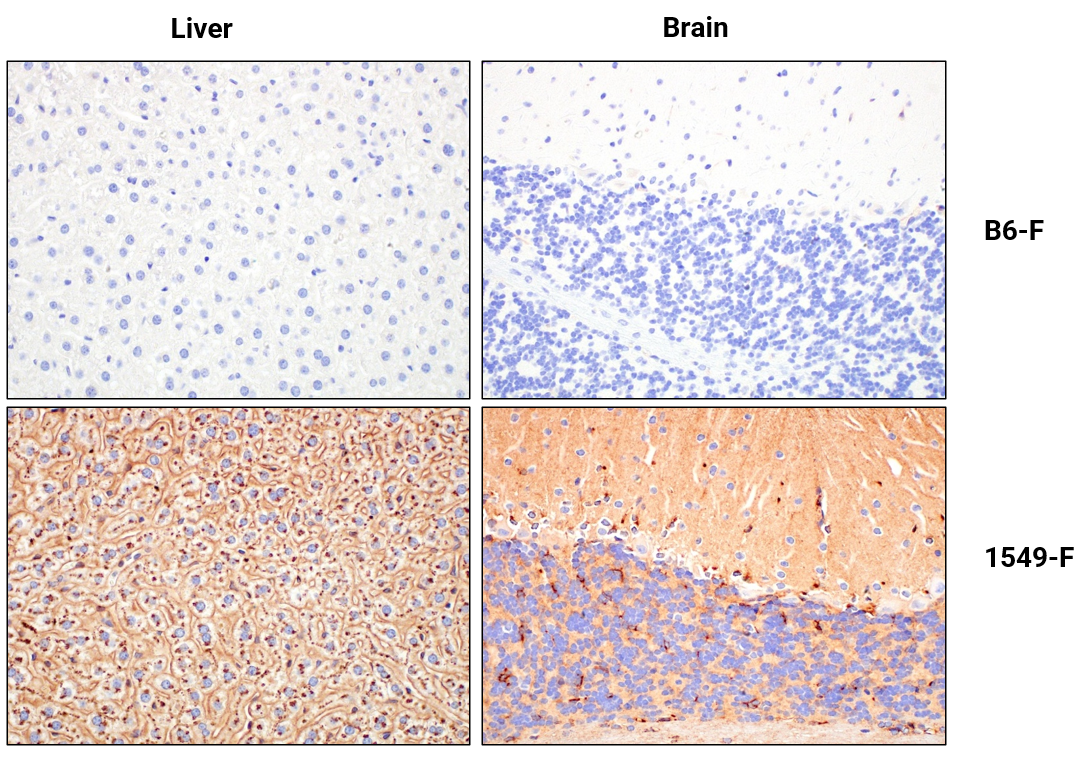
Figure 1: Immunohistochemical analysis of paraffin-embedded liver (left) or brain (right) from wild type C57BL/6NTac females (model #B6-F, top) and APOE4 females (model #1549-F, genotype hu/hu, bottom) mice (model #1549) using using ApoE (pan) (D7I9N) Rabbit mAb #13366 (human-reactive) from Cell Signaling Technology, Inc.
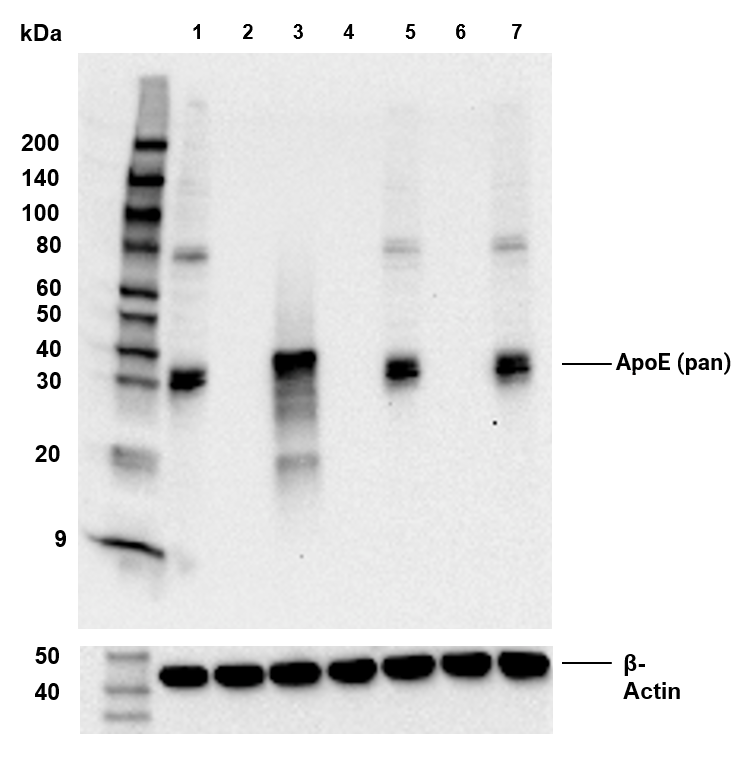
Figure 2: Western blot analysis of extracts from HepG2 cells (lane 1), 293T mock transfected (lane 2) or transiently transfected with a construct expressing ApoE4 (lane 3), whole liver extracts from wild type female C57BL/6NTac mice (model #B6-F, lane 4), or female ApoE4 knock-in (model #1549-F, lane 5), whole brain extracts from wild type female C57BL/6NTac mice (model # B6-F, lane 6), or female ApoE4 knock-in (model # 1549-F, lane 7), using ApoE (pan) (D7I9N) Rabbit mAb #13366 (human-reactive, upper) and β-Actin (D6A8) Rabbit mAb #8457 (lower), both antibodies from from Cell Signaling Technology, Inc.
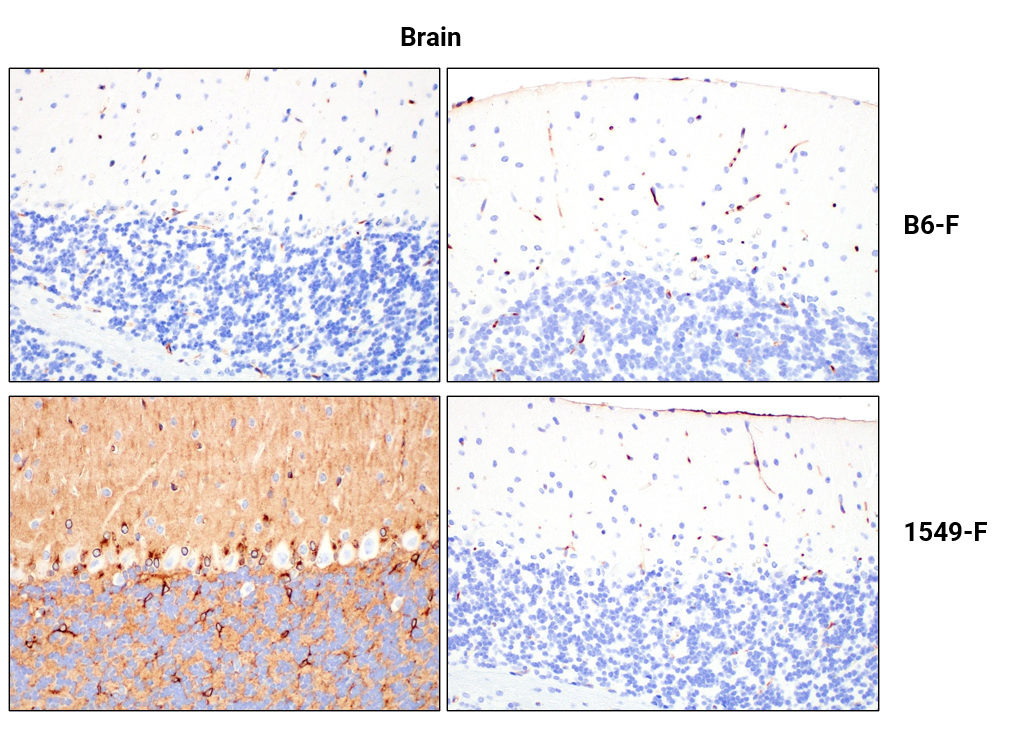
Figure 3: Immunohistochemical analysis of paraffin-embedded brain from wild type C57BL/6NTac female mice (model #B6-F, top) and APOE4 female mice (model #1549-F, genotype hu/hu, bottom) using ApoE (pan) (E8C2U) Mouse mAb #74417 (human-reactive, left) compared to concentration-matched Mouse (E7Q5L) mAb IgG2b Isotype Control #53484 (right), both antibodies from Cell Signaling Technology, Inc.
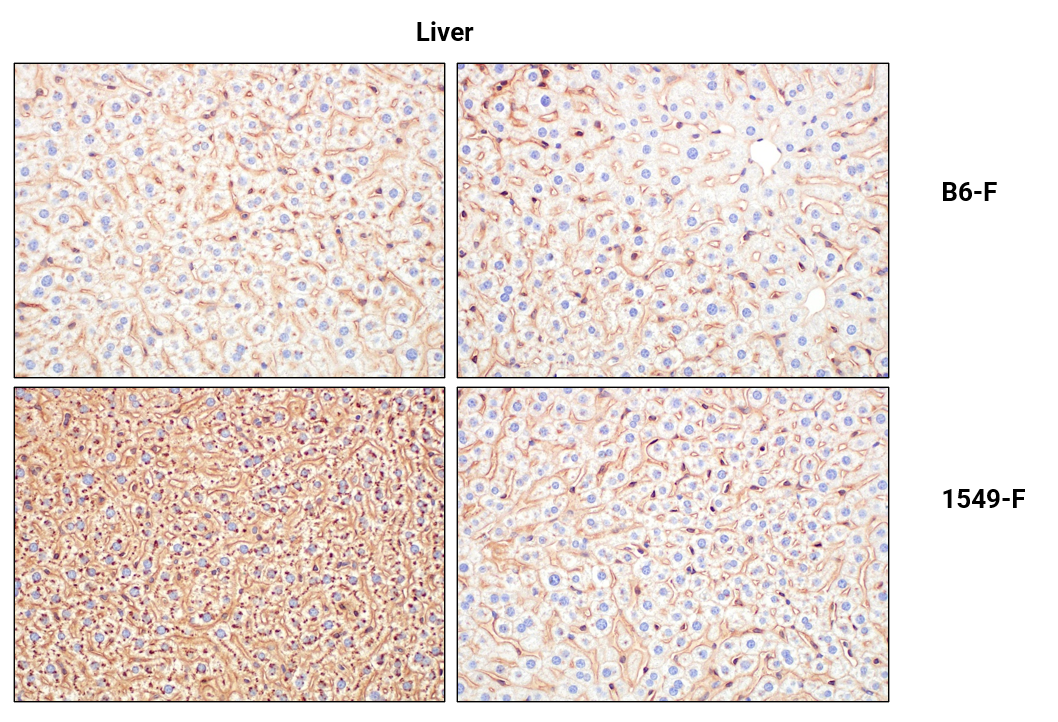
Figure 4: Immunohistochemical analysis of paraffin-embedded liver from wild type C57BL/6NTac female mice (model #B6-F, top) and APOE4 female mice (model #1549-F, genotype hu/hu, bottom) using ApoE (pan) (E8C2U) Mouse mAb #74417 (human-reactive, left) compared to concentration-matched Mouse (E7Q5L) mAb IgG2b Isotype Control #53484 (right), both antibodies from Cell Signaling Technology, Inc.
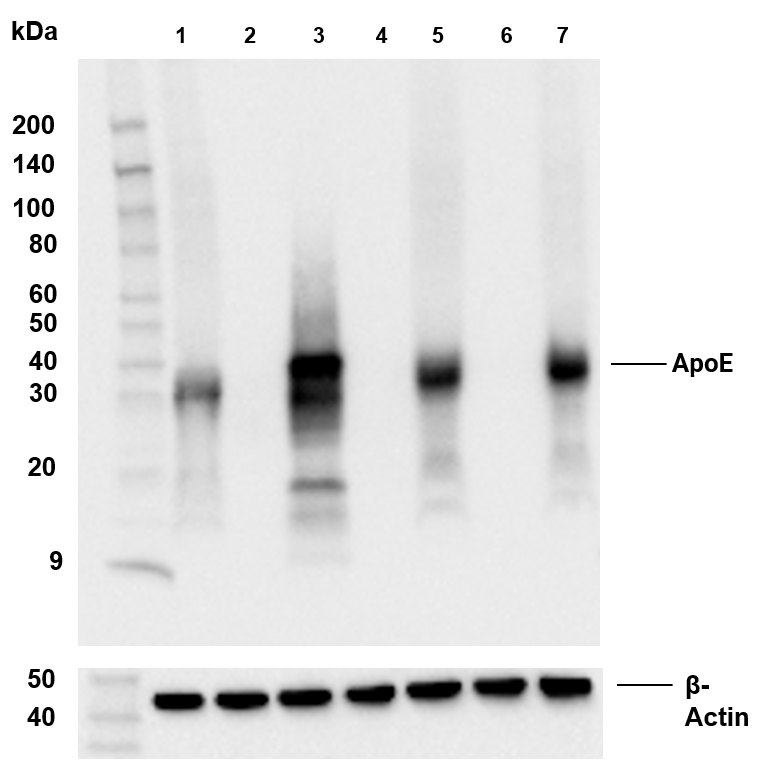
Figure 5: Western blot analysis of extracts from HepG2 cells (lane 1), 293T mock transfected (lane 2) or transiently transfected with a construct expressing ApoE4 (lane 3), whole liver extracts from wild type C57BL/6NTac female mice (model #B6-F, lane 4), or female ApoE4 knock-in mice (model #1549-F, lane 5), whole brain extracts from wild type C57BL/6NTac female mice (model #B6-F, lane 6), or female ApoE4 knock-in mice (model 1549-F, lane 7), using ApoE (E8C2U) Mouse mAb #74417 (human-reactive, upper) and β-Actin (D6A8) Rabbit mAb #8457 (lower), both antibodies from from Cell Signaling Technology, Inc.
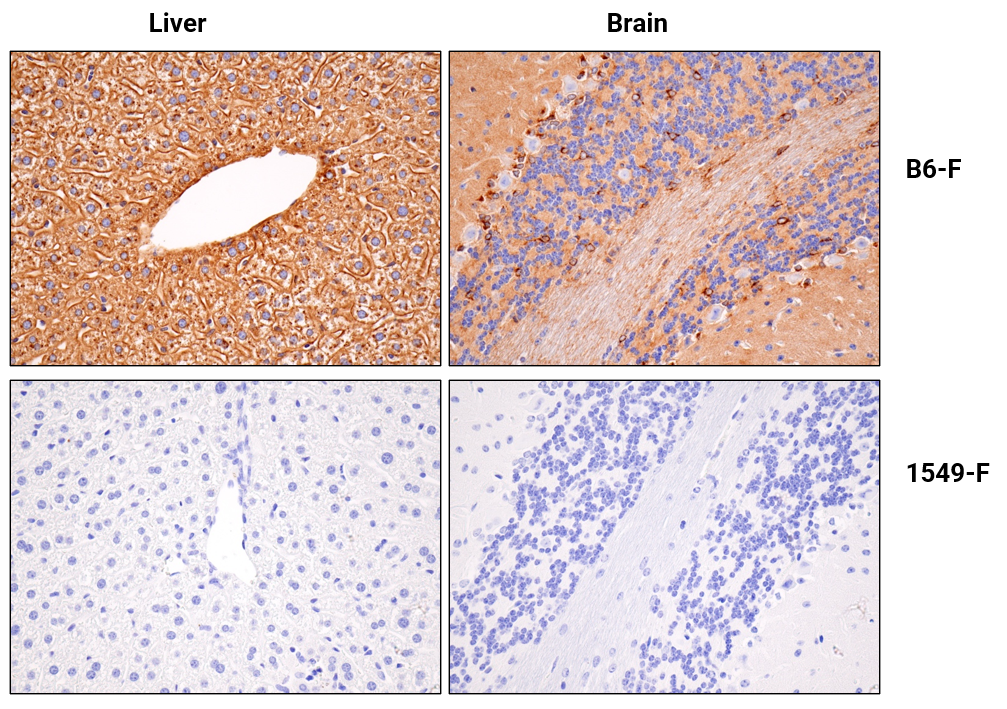
Figure 6: Immunohistochemical analysis of paraffin-embedded liver (left) or brain (right) from wild type C57BL/6NTac female mice (model #B6-F, top) and female APOE4 mice (model #1549-F, hu/hu, bottom) using ApoE (E7X2A) Rabbit mAb #49285 (mouse-reactive) from Cell Signaling Technology, Inc.

Figure 7: Western blot analysis of extracts from HepG2 cells (lane 1), 293T mock transfected (lane 2) or transiently transfected with a construct expressing ApoE4 (lane 3), whole liver extracts from wild type C57BL/6NTac female mice (model #B6-F, lane 4), or female ApoE4 knock-in (model #1549-F) (lane 5), whole brain extracts from wild type C57BL/6NTac female mice (model #B6-F, lane 6), or female ApoE4 knock-in mice (model #1549-F) (lane 7), using ApoE (E7X2A) Rabbit mAb #49285 (mouse-reactive, upper) and β-Actin (D6A8) Rabbit mAb #8457 (lower), both antibodies from Cell Signaling Technology, Inc.
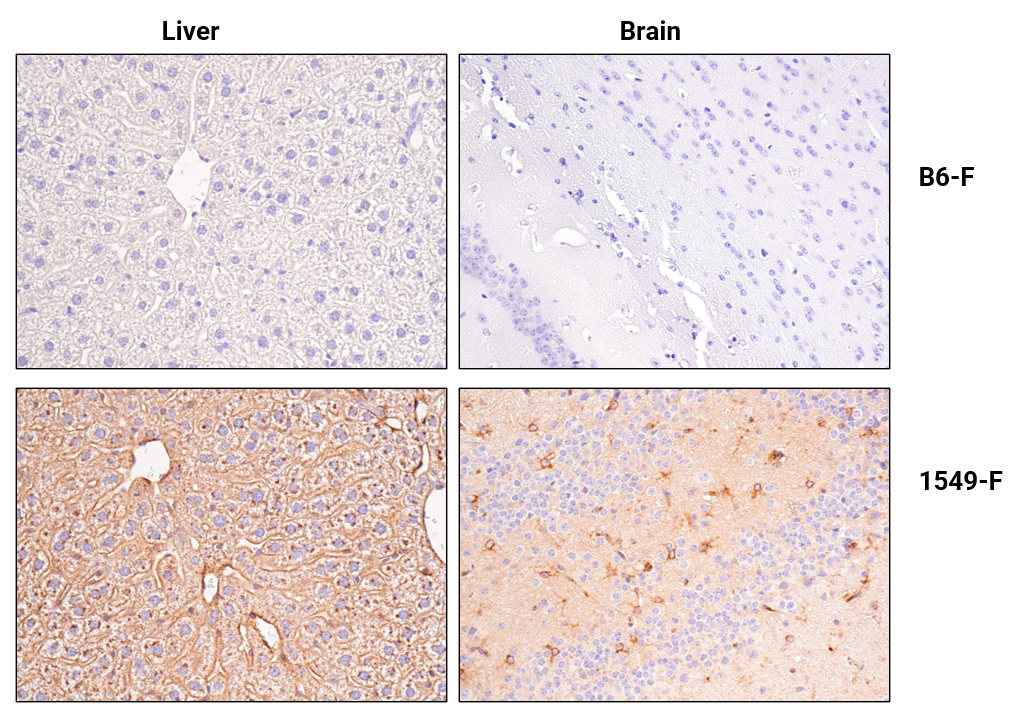
Figure 8: Immunohistochemical analysis of paraffin-embedded liver (left) or brain (right) from wild type C57BL/6NTac female mice (model #B6-F, top) and female APOE4 mice (model #1549-F, genotype hu/hu, bottom) using ApoE4 (E5M4L) Rabbit mAb (human-reactive) from Cell Signaling Technology, Inc.
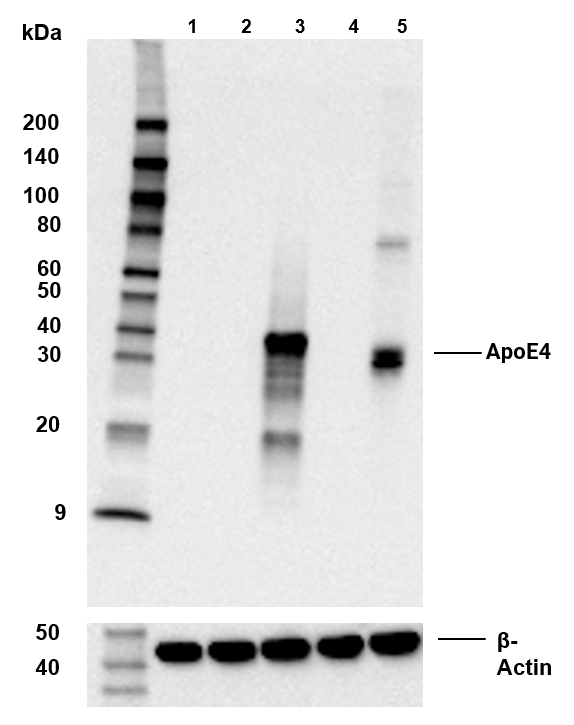
Figure 9: Western blot analysis of extracts from HepG2 cells (lane 1), 293T mock transfected (lane 2) or transiently transfected with a construct expressing ApoE4 (lane 3), whole liver extracts from wild type C57BL/6NTac female mice (model #B6-F, lane 4), or Female ApoE4 knock-in mice (model #1549-F, lane 5), using ApoE4 (E5M4L) Rabbit mAb #39327 (upper) and β-Actin (D6A8) Rabbit mAb #8457 (lower),both antibodies from Cell Signaling Technology, Inc.
- Licensing
- Pricing - USD
- Pricing - EUR
- Pricing - USD Nonprofit
- Pricing - EUR Nonprofit
- Select my Health Standard
- Get Custom Pricing Guide
APOE4
Conditions of Use for Taconic Transgenic Models™
Taconic Transgenic Models™ (Models) are produced and distributed under rights to patents and intellectual property licensed from various institutions. Taconic sells the Models to purchasers, grants to each purchaser a right under Taconic's rights in such licensed patents and intellectual property to use the purchased Model in consideration of purchasers' acknowledgement of and agreement to the Terms and Conditions for Taconic Models, Products and Services and the following terms of use:
- Title to these Models and biological materials derived from them remains with Taconic.
- The Models will be used for research purposes only.
- The Models will not be bred or cross-bred except to obtain embryos or fetuses required for research purposes unless additional rights have been granted in writing by Taconic.
- The Models and biological materials derived from them will not be distributed to third parties or used for commercial purposes.
- Non-profit purchasers may not use this Model and/or biological materials derived from it in sponsored research or contract research studies unless it is purchased at the for-profit price.
Pricing - USD
Murine Pathogen Free (MPF) Health Standard
1549 Female
1549-F Genotype hu/hu
Pilot-sized cohorts are readily available. Large cohort requests have a minimum 8-week lead time. An estimated lead time will be provided to you within 2-3 business days.
| Age in Weeks | Quantity 1 - 999 |
|---|---|
| 3 to 12 | $ 425.00 |
1549 Male
1549-M Genotype hu/hu
Pilot-sized cohorts are readily available. Large cohort requests have a minimum 8-week lead time. An estimated lead time will be provided to you within 2-3 business days.
| Age in Weeks | Quantity 1 - 999 |
|---|---|
| 3 to 12 | $ 425.00 |
Pricing - EUR
Murine Pathogen Free (MPF) Health Standard
1549 Female
1549-F Genotype hu/hu
Pilot-sized cohorts are readily available. Large cohort requests have a minimum 8-week lead time. An estimated lead time will be provided to you within 2-3 business days.
| Age in Weeks | Quantity 1 - 999 |
|---|---|
| 3 to 12 | 387,00 € |
1549 Male
1549-M Genotype hu/hu
Pilot-sized cohorts are readily available. Large cohort requests have a minimum 8-week lead time. An estimated lead time will be provided to you within 2-3 business days.
| Age in Weeks | Quantity 1 - 999 |
|---|---|
| 3 to 12 | 387,00 € |
Pricing - USD Nonprofit
Murine Pathogen Free (MPF) Health Standard
1549 Female
1549-F Genotype hu/hu
Pilot-sized cohorts are readily available. Large cohort requests have a minimum 8-week lead time. An estimated lead time will be provided to you within 2-3 business days.
| Age in Weeks | Quantity 1 - 999 |
|---|---|
| 3 to 12 | $ 325.00 |
1549 Male
1549-M Genotype hu/hu
Pilot-sized cohorts are readily available. Large cohort requests have a minimum 8-week lead time. An estimated lead time will be provided to you within 2-3 business days.
| Age in Weeks | Quantity 1 - 999 |
|---|---|
| 3 to 12 | $ 325.00 |
Pricing - EUR Nonprofit
Murine Pathogen Free (MPF) Health Standard
1549 Female
1549-F Genotype hu/hu
Pilot-sized cohorts are readily available. Large cohort requests have a minimum 8-week lead time. An estimated lead time will be provided to you within 2-3 business days.
| Age in Weeks | Quantity 1 - 999 |
|---|---|
| 3 to 12 | 296,00 € |
1549 Male
1549-M Genotype hu/hu
Pilot-sized cohorts are readily available. Large cohort requests have a minimum 8-week lead time. An estimated lead time will be provided to you within 2-3 business days.
| Age in Weeks | Quantity 1 - 999 |
|---|---|
| 3 to 12 | 296,00 € |
Select my Health Standard
Need help choosing the right Taconic Biosciences health standard for your research?
Use the Health Standard Selector to enter your exclusion list. The tool will tell you which health standards meet your requirements.
Get custom pricing guide
Schedule A Scientific Consultation
Speak with a PhD-level Field Application Scientist who can help you select the most appropriate model and maximize your experimental success.















.jpg)

.jpg)
.jpg)
.jpg)
.jpg)





.jpg)


.jpg)
.jpg)

.jpg)


.jpg)





.jpg)

.jpg)




